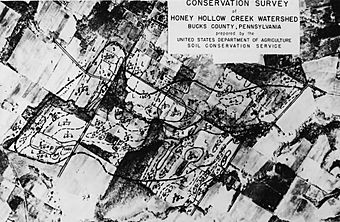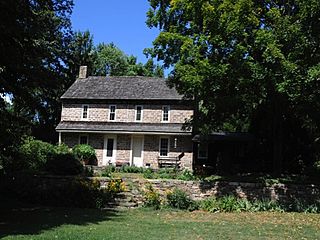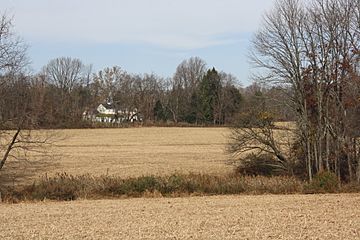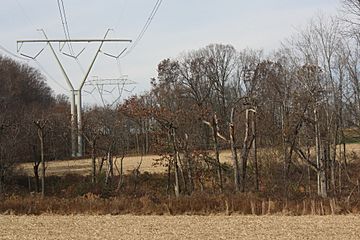Honey Hollow Watershed facts for kids
|
Honey Hollow Watershed
|
|
 |
|
| Nearest city | New Hope, Pennsylvania |
|---|---|
| Area | 650 acres (260 ha) |
| Built | 1933 |
| Architect | Soil Conservation Service |
| NRHP reference No. | 69000155 |
Quick facts for kids Significant dates |
|
| Added to NRHP | August 4, 1969 |
| Designated NHLD | August 4, 1969 |
The Honey Hollow Watershed is a 650-acre (about 2.6 square kilometers) area of land in Pennsylvania. It's located near New Hope, Pennsylvania, on the south side of the Delaware River. This special place is famous because it was the first privately owned area in the United States to focus on soil conservation.
In 1933, five farmers who owned land here worked together to stop soil erosion. Erosion was a big problem caused by new farming methods in the early 1900s. Their efforts were very successful! Because of its importance, the Honey Hollow Watershed was named a National Historic Landmark in 1969.
Contents
Protecting the Land: The Honey Hollow Project
The Honey Hollow Watershed is in a countryside area called Solebury Township. It's west of the town of New Hope. This area has been used for farming since the mid-1700s.
Why Soil Conservation Was Needed
After World War I, new machines and ways of farming became popular. While these methods helped farmers grow more food, they also caused a lot of soil to wash away. This problem, called erosion, meant valuable topsoil was lost. It also caused dirt to build up in rivers and streams downstream.
The United States government knew about this problem by the late 1920s. In 1933, they started using conservation methods on government-owned land. However, it was not clear if they could make private landowners use these methods.
Farmers Take Action
The five farmers in Honey Hollow saw their own land suffering from erosion. They decided to work together to solve this shared problem. They reached out for help from the Soil Conservation Service. This government agency helps people protect natural resources.
Their project became a great example of how people could cooperate to save their land. By 1941, they had built special terraces and ditches to control water runoff on hills. They also planted hedges to help stop the soil from washing away.
National Attention for Honey Hollow
The success of the Honey Hollow project gained attention across the country. In 1944, Henry A. Wallace, who was the Vice President of the United States at the time, visited the watershed. This showed how important their work was.
A famous conservationist named Louis Bromfield also became involved with the project. One of the farmers, P. Alton Waring, even wrote about their teamwork. He shared their story in a publication from the United States Department of Agriculture and in a magazine called "The Land."
The Honey Hollow Watershed was officially recognized as a National Historic Landmark in 1969. This honor means it's a place of great historical importance to the nation.
Gallery






